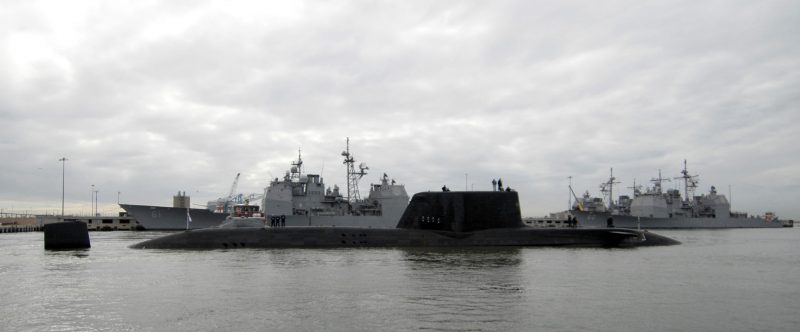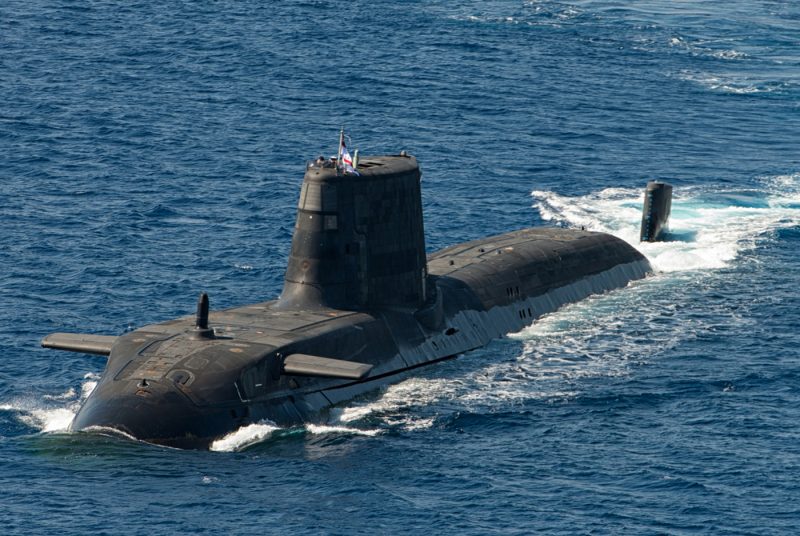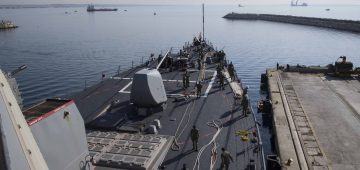(It really needs a dozen hunter-killers to safeguard the nation)

Hot on the heels of the threat to rip out the heart of the amphibious forces and denude the Royal Navy of adequate numbers of Wildcat helicopters, came potential cancellation of a seventh Astute Class attack submarine (SSN). The news that the programme could be curtailed at just half a dozen boats caused consternation and dismay in UK naval circles.
However, there are those who say the British fleet must cut its cloth and that savings should be made in the name of filling the black hole in defence funding – itself created by mismanagement under successive governments, reducing the proportion of GDP committed to Defence to a pathetic level, alongside poorly executed procurement programmes.
Yet defence is not a business, it is an insurance policy, so who would insure their car or their life by cutting the cloth to suit the available funds? And it is ridiculous to apportion funds on a fair share basis between government departments, especially when it appears nobody in the Cabinet, with the possible exception of the new Secretary of State for Defence, truly understands what Defence is for (and how nuclear deterrence needs strong conventional forces to make sense).
Despite not understanding Defence, UK governments in recent times have proposed that we should be grateful for the Royal Navy’s new carriers and issue soothing words about ‘a bigger navy’ and ‘massive investment’. They also point to new Offshore Patrol Vessels (OPVs), frigates under construction etc etc. They do not mention that such expansion is too little, with too much invested in ships that would not survive long in any war against a serious opponent.
Even those few that are being built are taking too long. The first City Class (Type 26) frigate is already under construction but won’t commission until the mid-2020s. The UK should be able to build such a ship by 2019. It took Fincantieri just three years to construct Cunard’s massive liner Queen Elizabeth, a vessel just as, if not more, complicated than a simple frigate. In France and Italy they seem to be able to churn out frigates at a very rapid rate, yet Britain is apparently incapable of matching their pace. The French and Italian fleets modernize with alacrity to meet the new threat reality, while the UK takes forever to respond.
Our dangerous world has moved well beyond the peace dividend 1990s. We are in a new era of great power rivalry, escalating threats (especially in the maritime environment) with the Chinese seeking to seize control of the South China Sea and the Russians looking to secure dominance in the Arctic, Black Sea and eastern Mediterranean.
Meanwhile, the Iranians are ensuring they can close the Strait of Hormuz at will with their Anti-Shipping Missiles (ASM) while the North Koreans are working on a nuclear missile submarine programme, to reinforce their already large (if somewhat antiquated) submarine force.
In the face of such threats it is important to send the right signals, to make the correct level of investment – and fast. Above all it is important to give your navy enough of the right equipment, plenty of highly trained people, while ensuring it is configured to take on the actual threats rather than the ones you wish it faced. The Royal Navy must have enough critical mass to fight, to take losses and replace them, which it currently does not possess.
Accepting the cutting of any of the present day order of battle, or reductions in future equipment, would represent utter complacency. If Defence is an insurance policy, no one except an idiot would approach the problem from the perspective of “how much will you give”, rather than the “what do I need to spend in order to protect myself”? If funds are tight you buy and insure a cheaper car or you stop driving. Would you ride a motorbike wearing a damaged crash helmet?

For the UK to even consider not building the seventh Astute Class submarine was a sign of weakness and displayed a lack of reality in government about how much investment in Defence is needed across the board. Fortunately the disquiet stirred up by the prospect of the seventh boat being cancelled eventually persuaded a Government minister to issue an official denial that was the case.
A couple of weeks later Prime Minister Theresa May stood up in Parliament to announced that £600 million was being spent on ensuring the new generation ballistic missile submarines (the Dreadnought Class, aka Trident Successors) will be built.
Mrs May announced in Parliament: ‘The Ministry of Defence will have access to £600 million this coming financial year for the MoD’s Dreadnought submarine programme. Today’s announcement will ensure that the work to rebuild the UK’s new world-class nuclear submarines remains on schedule, and it is another sign of the deep commitment this Government have to keeping our country safe.’ The Prime Minister added: ‘We continue to exceed the NATO 2 per cent target and remain the second biggest defence spender in NATO.’
Boasting about ‘exceeding’ the two per cent target is, as has been pointed out before by Odin, is like bragging you are the least puny in a group of weaklings. The other ‘biggest spender in NATO’ is the USA, which by far exceeds the spending of any other alliance nation. NATO nations as a whole spend much too little on defence.
The two per cent Mrs May referred to is actually the minimum NATO requires, NOT the ideal target while the UK has used smoke and mirrors to reach its current level of spending, loading all sorts of things into the defence budget that do not deliver capabilities and force levels to the front line.

The Dreadnought Class submarine programme is in essence a vastly expensive means of trying to do Defence on the cheap by avoiding the necessity to properly fund large enough conventional forces. It will only lead to a situation one day where an enemy will believe he can chance his arm with a non-nuclear attack – possibly swiftly overwhelming Britain’s small non-nuclear military forces – and leaving it with the choice of capitulating or using the nukes.
Nuclear weapons are indeed meant to be the last line of defence, the weapons of last resort. However, gradual escalation through stages of conventional deterrence – and then, if need be, ordering those conventional forces to fight – is meant to ensure you never need contemplate pressing the nuclear button.
Today’s UK political and military leaders must rapidly get to grips with how vast the challenge is to secure an island nation along with its people and interests around the world – resisting the seductive chimera of a nuclear-tipped silver bullet as first recourse for strategic defence. They must ask what the real level of required spending on Defence is – and it is not around two per cent, but more like three per cent (or more).
The shopping list includes building more Astutes and/or initiating a programme to construct their successors. For years the UK has been slowing the build rate of attack submarines to keep Barrow open with a much-reduced throughput (and therefore more expensive costs per unit). In reality at least ten Astute Class SSNs should be constructed in the time it is taking to build seven (or just six). Proper defence of the realm actually requires around a dozen SSNs (which would be a return to where the RN was in 2004, when it was a properly balanced fleet, including 31 destroyers and frigates).

-
This Odin’s Eye text is an edited and revised version of the commentary that was published in the April 2018 edition of WARSHIPS IFR.






Comments
Sorry, comments are closed for this item